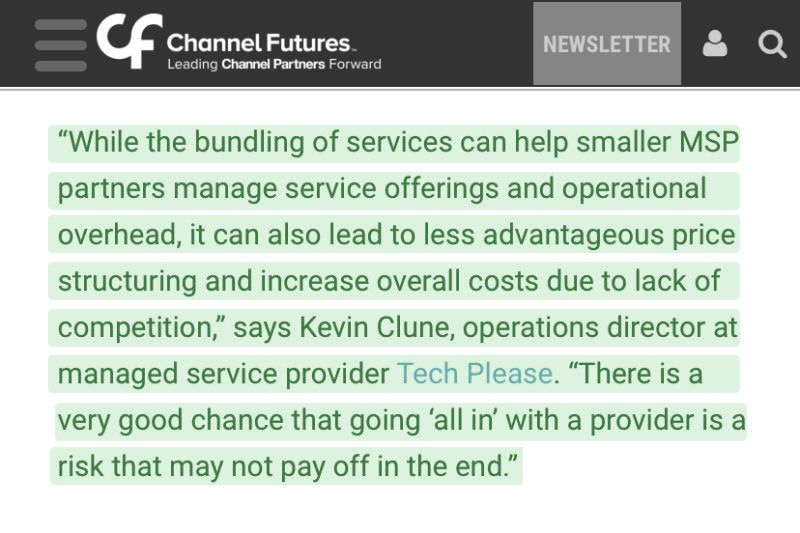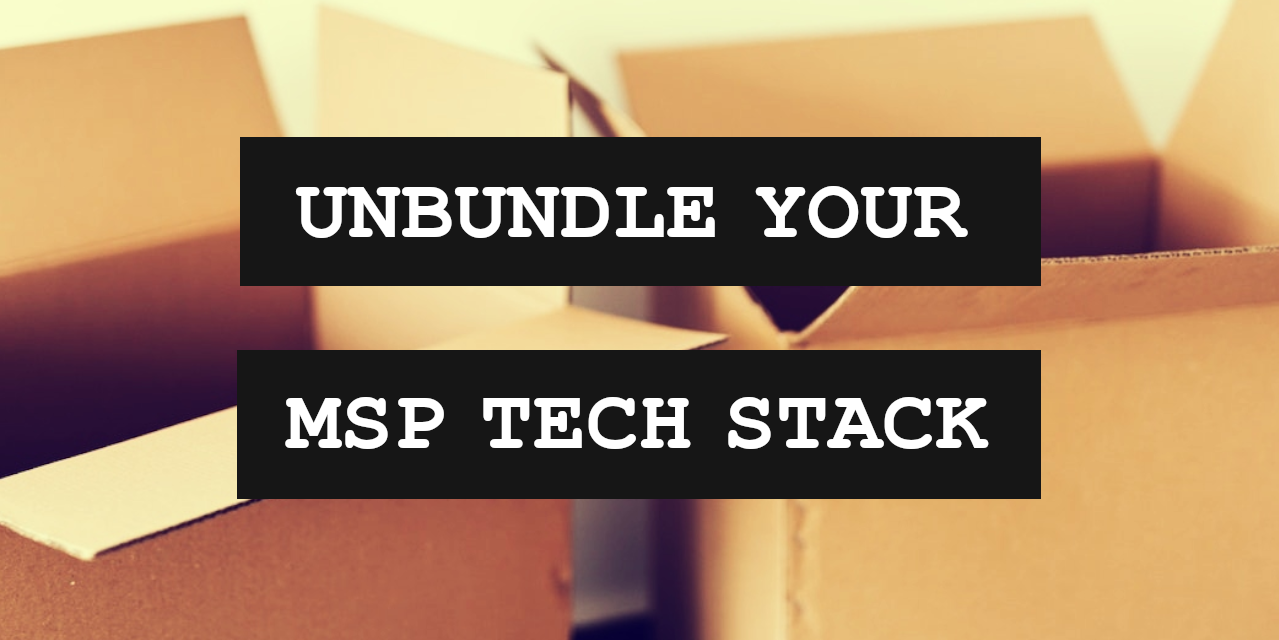Hidden Costs of Bundled Products
While I have been more outspoken against vendor consolidation recently, the current state of the industry does not come as a surprise. In fact, I was speaking out about this issue publicly even during my time as an MSP. Here is a comment from a 2018 Channel Futures article where I began to question whether or not bundling was actually beneficial to the industry.

I bring up these past comments, not to say “I told you so,” but rather to point out that the industry will continue to move in this direction as long as we let it. It was trending that way 5 years ago, and it will continue to trend that way unless there is a major shift in buying behavior in the vendor channel.
In my opinion, service “bundling” is the sales and marketing spin that gets slapped on consolidation, to give MSPs the illusion that it is a feature and not a bug. Many would like you to believe that purchasing your entire tech stack through a single source is the “convenient” choice, however even if that is true there are a lot of hidden costs that come with that.
Here are just a few of the risks that MSPs take when purchasing the majority of their tech stack through a single vendor:
Single Point of Failure
The most obvious risk when bundling services together is that you suddenly find yourself with a single point of failure in your business. Most MSPs should be able to relate to this from a technical perspective as it is a common practice to avoid these single points of failure when building out a network or other technical infrastructure.
The reason that it is so critical to avoid, is because bad things happen even to good people (and good products). Software can experience downtime and get hacked, while companies can also experience financial loss and make changes on a whim. You can’t predict what this negative event will be, but you can minimize your exposure to it. For those with a fully bundled tech stack, this can create a domino effect that halts your business and leaves you to pick up the pieces.
Complete Vendor Capture
While growing with your vendor(s) is not such a bad thing, I have seen it get to an irreversible point of no return. This is when you have invested so much time, energy and money building your business on top of a set of products that you literally can not remove them without significant harm to your business. If a single point-of-failure is like dominos, vendor capture is like the game of jenga, and your “all-in-one” provider is the bottom row of blocks. One little tap or tug in the wrong direction and the whole tower comes crashing down.
I call this “vendor capture” because that is really what is occurring here. This is not to say it is malicious and that these vendors have bad intent, however I do believe that this capture is intentional. Who wouldn’t want their product or service so tightly integrated into their customer’s business that it can’t survive without it? This stickiness is part of the retention strategy and offsets any customer service issues that they may have.
The Ultimate Guide To Cash Flow For Managed Services
Sponsored by Alternative Payments & Zest
No Negotiation Leverage
When you get locked into a bundle of products, you essentially lose any leverage that you had on an individual product basis. When the vendors decide to increase your prices (and they always do), you will often find that this increase is across every product in the bundle. This can be a lot to swallow at once and unfortunately since these product costs are all tied together, you lose any ability you have to negotiate.
Given that most vendors who bundle also require lengthy contracts and sell licenses in blocks or tiers, this can also be a long and painful process to endure. I have talked to several MSPs over the years that have decided to buy out up to a year of their contract simply to stop the bleeding and break free of this, giving them the ability to finally re-negotiate a fair deal across a variety of vendors.
Lack of Differentiation
In my opinion, the job of an MSP is to become the last-mile service provider for a suite of small business technology products, hand-picked on a consultative basis. If that suite of products is being purchased as part of an unbreakable bundle, it really dilutes the value that the MSP is able to provide. This is especially true when the majority of the industry purchases the same bundle from the same vendor.
We are at a time in the industry where end customers are looking for specialization more so than years prior. To accomplish these needs, an MSP must be willing to explore more niche products that are not necessarily “one-size fits all” across their entire customer base. This next-level procurement can act as a tangible differentiator in a way that no bundle ever could.
Roadmap Dependence
Product roadmaps should be highly considered when making a purchasing decision for your tech stack. If you want to build your business around a set of tools, you should have a good understanding of where those products are headed and not necessarily where they are today. For example, if you had two products that looked exactly the same today but one had an innovative and ambitious roadmap and the other was just looking to maintain the status quo, you would obviously want to choose the former.
When you have products that are bundled together, you have essentially boarded a train with a one-way ticket and no ability to control the speed or destination. Many of the vendors who bundle services together have very cautious and stagnant roadmaps and this lack of ambition extends to each product in the stack. This can put your business years behind the curve the length of your contract as you are unable to take advantage of new technologies that are being developed. That is until your mega-vendor decides to make an acquisition and slaps their logo on it.
The ‘Unbundled’ Philosophy
Now that we’ve focused on the negatives that come with bundling products, let’s look at some of the positives that might come from avoiding this practice altogether. We call this the ‘unbundled’ philosophy and it is really just a way to make sure that your business can avoid the pitfalls that come with being overly-dependent on any one entity.
Here are a few of the principles that I believe MSPs should consider when taking an un-bundled approach to building their tech stack:
The Ultimate Guide To Cash Flow For Managed Services
Sponsored by Alternative Payments & Zest
Best-in-Class Solutions – You should always strive to use the best solution that you can reasonably afford for each product category. I understand that relationships with these vendors matter too and in some cases more than the product. That’s why I think you should look for the best partner for both you AND your customer and weigh out the quality of the product and partner experience appropriately.
Flexibility To Pivot – Your business should always have the ability to pivot into a new solution set whenever you choose. Everytime you gain or lose a customer, your business changes. You should be able to adapt and grow accordingly without the baggage of an overweight tech stack holding you back.
Real-Time License Fees – License counts are always subject to change. Your customer will hire and fire people, and so will you. You should always look to pay as close to real-time licensing fees as possible as part of the contracts that make up your tech stack. This is the default setting for the majority of the SaaS industry, so there is no reason why MSPs should have to buy licenses in static blocks for pre-defined periods of time.
Short-Term Contracts – You should try to avoid long term or multi-year contracts whenever possible. As the vendor channel has seen a massive increase in competition, many of the newly launched products are being offered with no contract or on a month-to-month basis. I believe this is incredibly important, as it gives your business complete freedom to reevaluate your stack on a constant basis.
End-Client Specialization – Since the customers’ needs are constantly changing, and so are compliance requirements that they are held to, MSPs should have the ability to specialize their stack on an individual client or vertical basis. You should not be forced to use ill-fitting products simply because of the way your partner agreements are structured and the need to achieve volume-based pricing for profitability.
Seamless Integrations – Just because the billing and relationships are unbundled, that doesn’t mean that the products shouldn’t be compatible. You should always look to find products that work together seamlessly and share similar philosophies in how they develop products and operate their businesses. Most of these integrations already exist, but if they don’t, the ideal vendors will be willing to put them on their roadmap for consideration upon your request.
Conclusion
I realize that having all of these positives without the negatives can seem like an overly optimistic pipe-dream, but it is important to define what it is we are working toward. I believe that with the volume of new products that are coming to market right now in every category, there has never been a better time to take control of your tech stack and do so in a way that puts you back in the driver seat. I said it before, but it is worth repeating; if the buying behavior doesn’t change, neither will the outcomes, so it is up to the MSP community to decide what they want the vendor landscape to look like, now and in the future.

SPONSORED BY ZEST

















